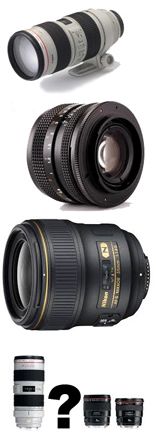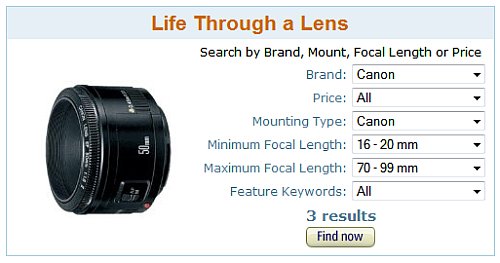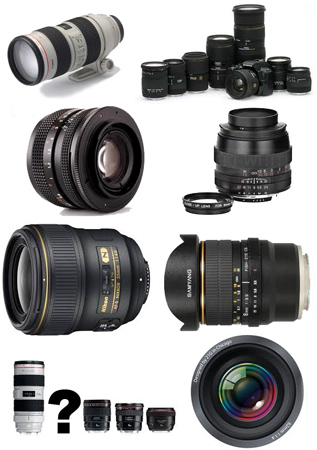
Buying lenses is not as straight forward as it seems. There is a lot to consider.
Critical features to consider when buying lenses
The key to buying lenses is knowing what you want to achieve with your purchase. It is also important to have a clear idea of your budget. However, there are a whole range of other things that have an impact too.
There are a wide range of photographic lenses to buy for most cameras. Each has their own characteristics. A lens can easily cost more than your camera. Take care with your choice. The wrong decision can leave you with a lens that is not suitable to your interest.
Getting started on buying lenses
First of all sit down and write down all the reasons you want a lens. Also, write down all the possible things against buying lenses (of any sort) at this time. Try to convince yourself you really don’t need to buy. In most cases of purchase-fever the buyer gets things they don’t want. So, when spending lots of money you should be careful. Buying lenses is a big investment. If you make the right choice then your purchase may last you through a number of camera bodies. So think carefully and make the right decision up front. That way your money will not be wasted.
I have purchased about thirty lenses over the years. Of those, five were bad purchases. Four were impulse buys – not suited to my needs. In another case, a hasty decision meant I bought a poor quality lens. From this experience I have compiled the list below to help you when buying lenses in future.
Some of the basics for buying lenses
1. Focal Length:
- a. Measured in millimeters.
- b. Smaller Focal lengths provide wider angles of view.
- c. Longer focal lengths show less of the scene and tend to magnify the view.
- d. Distortion may be found at the extremes of focal length.
2. Aperture:
- a. Measured in f stops (eg.f2.8 [wide open] f5.6 [medium], f16 [small aperture]).
- b. Wide aperture lets in most light – faster shutter speeds possible (eg. F2.8).
- c. Small aperture lets in less light – requires longer shutter opening (eg. F22).
- d. Wide aperture provides short depth of field.
- e. Smaller apertures gives sharpness throughout the depth of the picture.
- f. Zooms – Aperture size gets smaller with increase in focal length.
3. Stabilisation:
- a. Slow shutter speeds mean more chance of camera movement, which makes blur.
- b. Stabilised lenses typically give one or two f stops smaller aperture without more blur; the stabilisation compensates for movement.
- c. Cost is higher if the lens is stabilised.
- d. Canon = IS (image stabilisation); Nikon = VR (vibration reduction); Sigma = OS (optical
stabilisation); etc… - e. Stabilisation may be in the camera rather than the lens.
General considerations when buying lenses
1. Optical characteristics
- a. Glass optical quality varies with the production process and ingredients.
- b. More lens elements/groups reduces light able to pass through the lens.
- c. High quality optical glass does not reduce light as much as cheap glass.
- d. Each manufacturer has a specific type of glass for higher quality lenses.
- e. Optical aberrations come from low quality optical glass.
- f. Lens optical coatings reduce aberrations and flare.
- g. Distortions are caused by specific groupings of lenses.
2. Motors/drives:
- a. Used to drive the aperture control; stabilisation and auto-focus.
- b. Sometimes noisy – not desirable for wildlife shots.
- c. Adds a lot of weight to the lens.
- d. Not necessary on manual-focus prime lenses.
- e. Some cameras have them only for auto-focus.
- f. Older lens models have slower, sometimes heavier, often noisier motors.
3. Weight:
- a. Often forgotten attribute. If you can’t carry it, then it’s no good for you!
- b. Weight often increases with wider apertures – fast lenses may be too heavy for you.
- c. Weight will tend to increase the amount of hand-shake movement.
- d. Stabilisation motors put a lot of weight on the lens too.
4. Sensor optimisation
- a. Lens focal lengths are usually stated for full-frame cameras (quoted for 35mm sensors).
But… - b. A cropped sensor will still have the same focal length lenses as a full-frame, but image size will multiply it by the crop factor. (See: crop factor).
So, - c. Cropped sensors increase the lenses’ magnification. Eg. Canon APS-C lenses are optimised for the Canon cropped sensor. The crop factor is 1.6. So a 100mm lens on a Canon 450D is actually equivalent to a 160mm focal length on a canon full frame camera like the 5D.
- d. Different crop factors apply to different manufacturers and cameras.
- e. Some optimised lenses will not fit different sensor sized cameras – APS-C – check the fit and crop size in the specification for the lens.
More specific issues affecting you when buying lenses
1. Zoom vs. Prime
- a. Zoom lenses give you a variable focal length; you control magnification.
- b. Prime lenses have fixed focal length. Move nearer/further to change the angle of view.
- c. Zooms give you focal control over the framed view.
- d. Primes tend to be higher quality lenses, sharper, faster (wider apertures).
- e. Primes more compositionally challenging.
- f. Primes – colours and exposure control more realistic.
2. Why you want this lens…
Make sure you know why you are buying lenses. Consider these points below:
Fisheye lenses (8 – 18mm on cropped sensor; 14 – 18 mm on full frame)
- Introduces central focus with peripheral distortion.
- Highly creative focus provides extreme visual views drawing the eye to the centre.
- Used primarily for highlighting specific subjects or attributes of the scene.
- Ideal (according to some) for full-frame sensor work for portraits.
Zoom lenses (long focal lengths 50 to 600mm)
- Sometimes dubious quality in some parts of the zoom.
- Flexible for many purposes, but especially wildlife photography at longer focal lengths.
- Ideal for getting ‘into’ the shot.
- Creativity related to the placement of the subject in the frame; angle of view variable.
- Extreme zooms (350 – 800mm zoom ranges)(Very long range lenses greater than 800mm available).
- Extreme expense – (expect cost around £5,000 for the 800mm sort of focal length).
- Excellent for specialist wildlife and long range work.
- Angle of view very limited at extreme end.
- Very heavy – absolutely requires tripod for longest ranges.
- Really only supportable for specialist work (professional wildlife photographer).
- Cheaper to hire for the odd trip.
- Macro (from around 35mm to 200 mm) (sometimes achieved using extension tubes).
- Used to get close-up shots of very small subjects.
- Focal length is artificially extended to magnify for close-up work – aim to get 1:1 or larger result.
- Can be used for longer views; tends to be at restricted apertures for non-macro work.
- Great for magnification shots.
- Great creativity scope.
- Tilt and Shift.
- Specialist – for control of where to place sharpness in the depth of field OR how to deal with
converging parallels (lines in the road or converging verticals in buildings).
Wide angle lenses (16 – 24 mm on cropped sensor) (24 – 35 mm on full frame sensor)
- Used for getting wide views of the subject; sweeping view across a scene.
- Some optical distortion at the very wide end accentuates central subjects.
- Tend to be used by landscapers; often capable of very small apertures (f22 – f36).
- Standard zoom lenses (35mm to 200mm of varying focal lengths).
- Provide great flexibility because can change from wide angle to magnification.
- Quality often highly price dependent.
- Optical quality variable with change in focal length.
- Very long focal lengths often have high f-stops (eg. F5.6).
Standard prime lens (50mm)
- Sees approximately what the human eye sees (full-frame sensor cameras).
- Slightly wide angle for cropped sensors.
- Usually good low light performance because of aperture size is usually wide.
- Approx.. 80mm for cropped sensors – good for portraits.
- Creativity allows for the same flexibility that the eye sees.
- Controlled angle of view is determined by photographers position (no zoom control).
- Standard prime lens (80mm).
Ultimately it is about image quality
When you are buying lenses consider what you are going to get. If you buy a cheap lens you will get a poor picture.
Most modern camera bodies are going to produce pretty good pictures. But if you stick a poor quality, budget lens on a camera it will give you a poor result. A top quality lens will serve you for many years. It will swap between bodies of the same manufacturer. It will produce quality pictures from your body.
On the other hand a poor quality cheap lens will degrade the ability of the camera body. Which will devalue your overall investment. It is pointless upgrading a body to a higher specifications if your lenses are not up to the same performance standard. Buying lenses is about setting your aspirations. Buying lenses of poor quality is about limiting your potential, for now and for years to come.
Buying lenses – checking the various options
The sheer number of lenses available is daunting. Try starting with a lens finder. This great Lens finder on Amazon.co.uk makes buying easier.
Note:
USA users may not be able to get the above “Lens finder on Amazon.co.uk” link. See below…
Link version for USA users: Amazon.com Lens Finder
Please report problems with these links.
If you are buying lenses enter the important factors for your lens choice. It returns a list of the lenses to suit that purpose. I find this an invaluable tool for helping to me to find a range of lenses from which to make my ideal purchase.
Comments, additions, amendments or ideas on this article? Contact Us
or why not leave a comment at the bottom of the page…
Like this article about Buying Lenses? Don’t miss the next article — sign up for tips by email.
Photokonnexion Photographic Glossary – Definitions and articles.
UK Lens finder on Amazon.co.uk
USA Lens finder on Amazon.com
Also on buying lenses: Finding lenses and buying to suit your needs.
What is an SLR?
Definition: Focal Length
Definition: Fast Lens
Definition: Zoom Lens
Definition: Telephoto lens
Definition: Prime Lens
Definition: Normal Lens
Definition: Wide Angle Lens; Wide-angle lens; Wide angle

Damon Guy (Netkonnexion)
See also: Editors ‘Bio’.
By Damon Guy see his profile on Google+.



